Applying the butler’s tourist area life cycle model to classify tourist destinations on Thanh Hoanghean’s coastline
Abstract: The author applied Butler's model of the life cycle of Tourst destinations, scorebased measures and visitor satisfaction surveys to classify tourism destinations along 184 km
of Thanh Hoa - Nghe An's coastline. The results of a total of 32 tourism destinations were
evaluated and classified in this region with 21 sites, during the exploration phase, 9 sites at
the involvement stage and only 2 sites, is Sam Son and Cua Lo, reached the development
stage. The study also proposed solutions to 21 points in the exploration stage to other stages
and 9 points in the phase to participate in the development phase within 5-10 years.
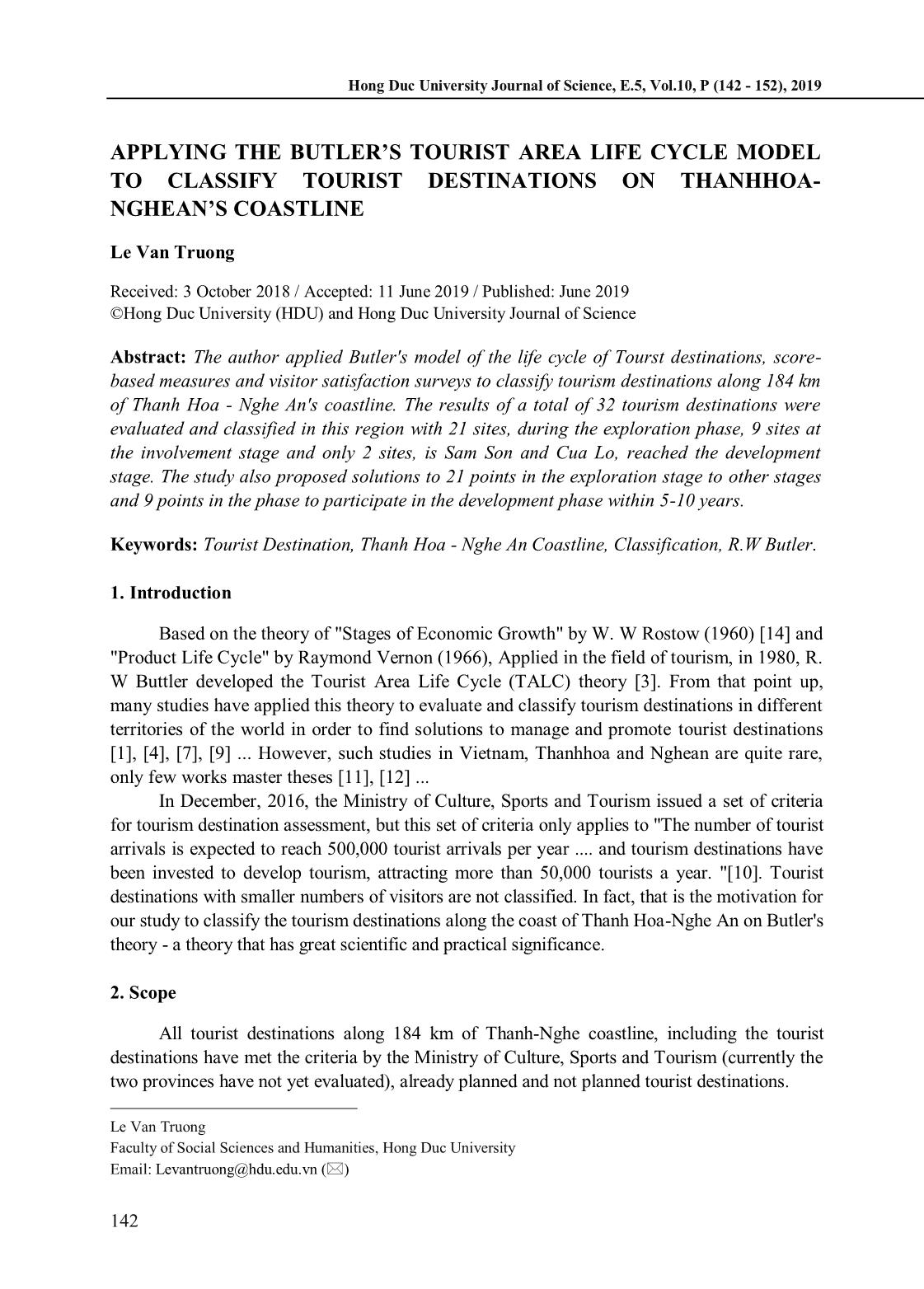
Trang 1
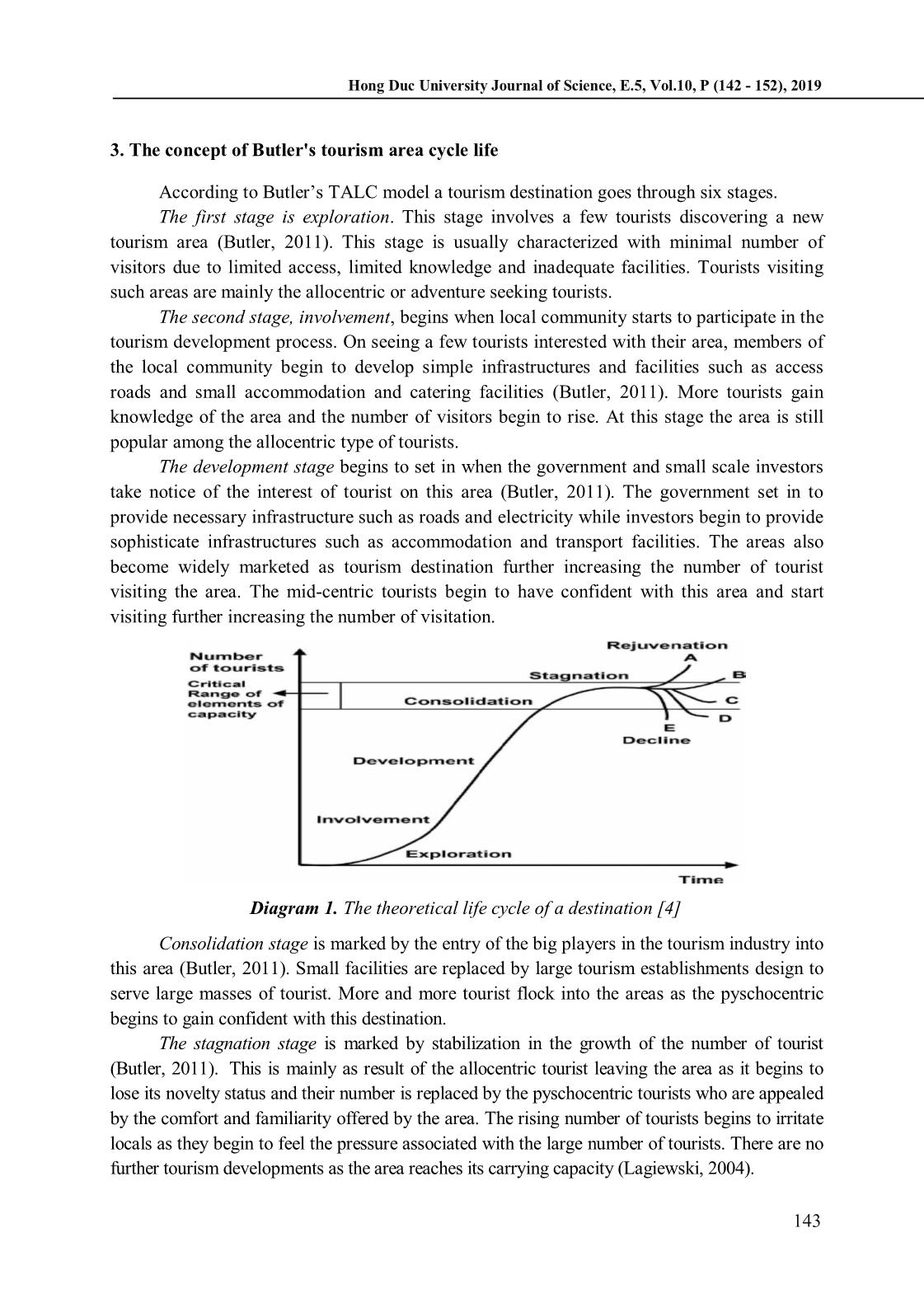
Trang 2
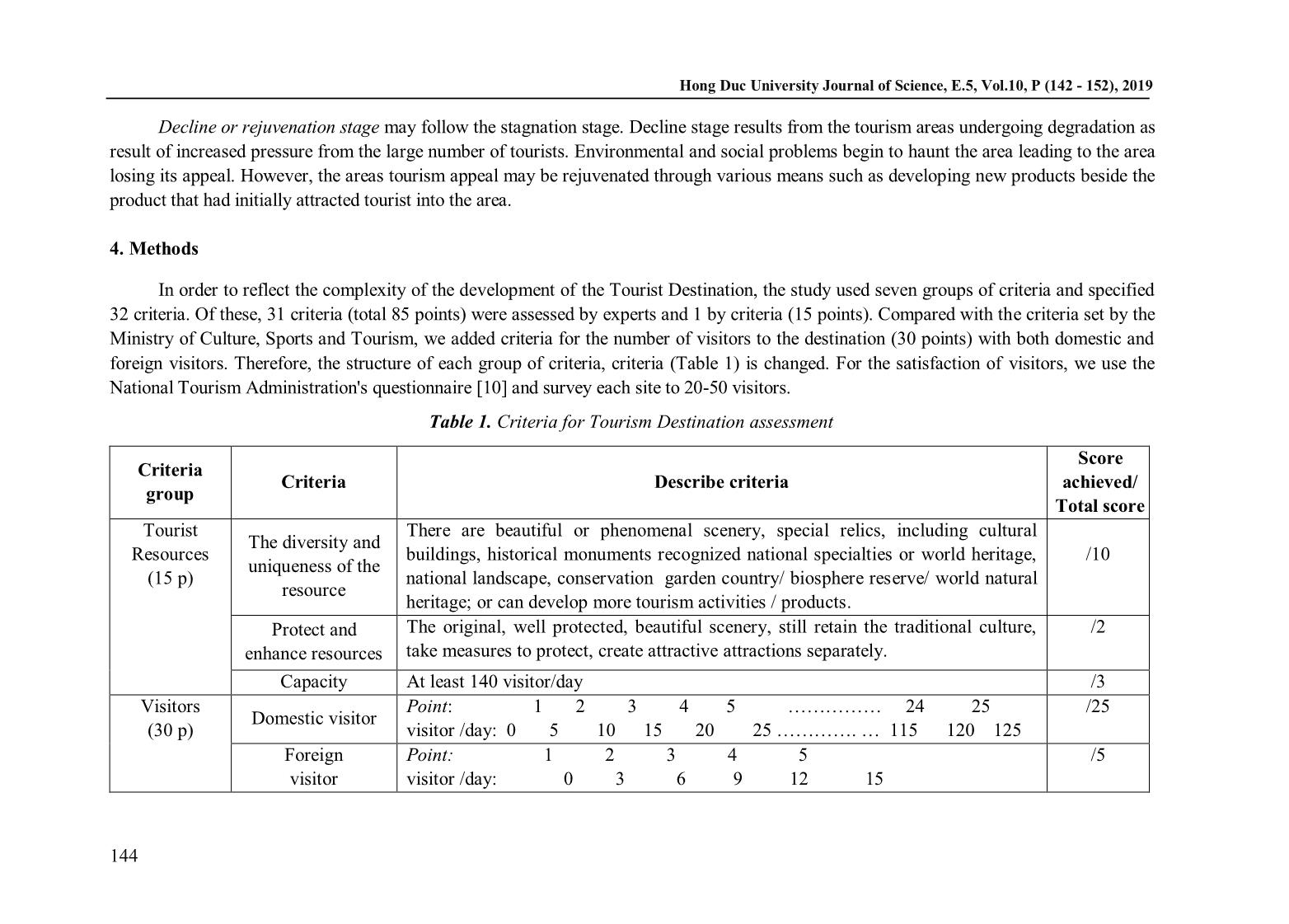
Trang 3
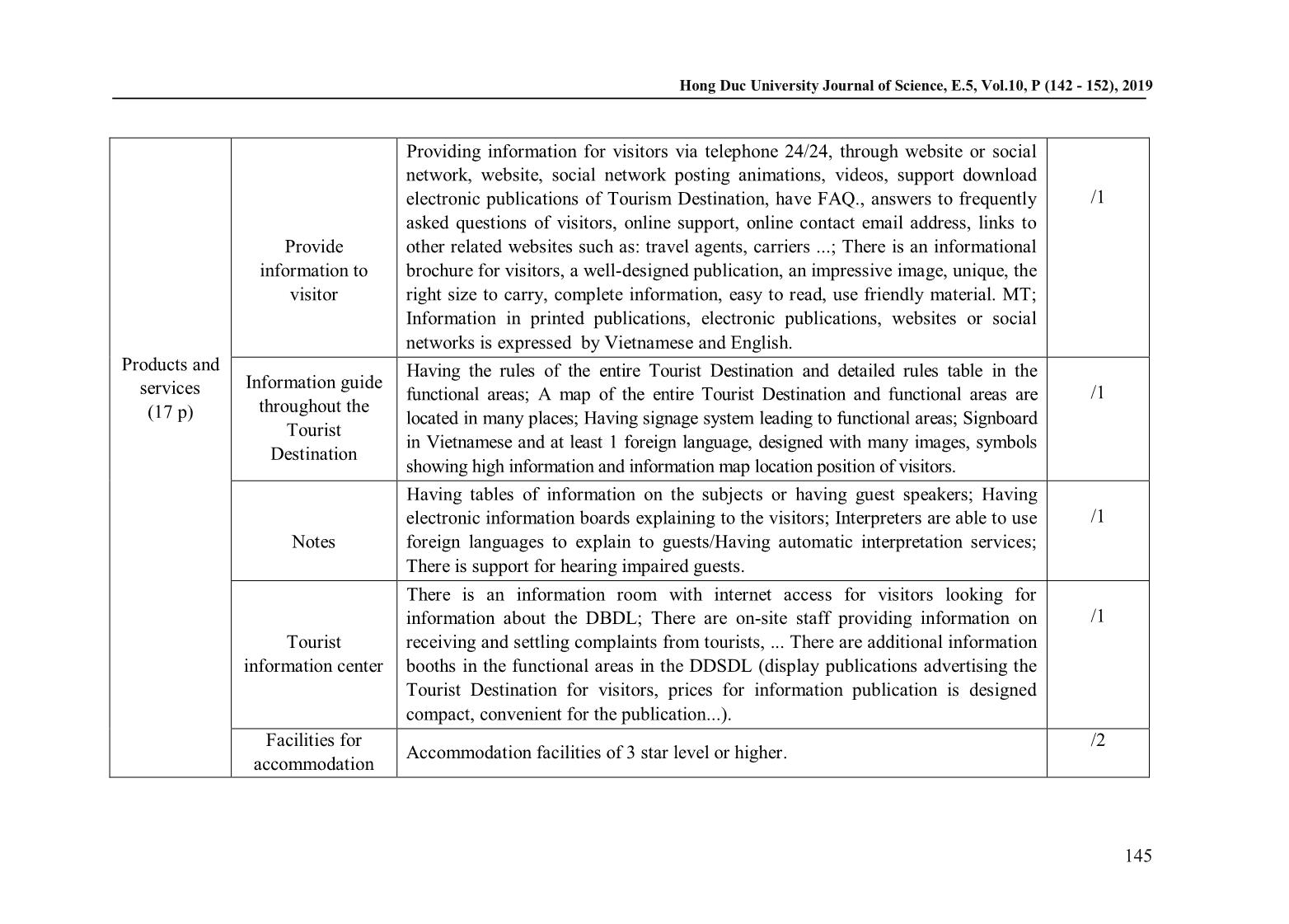
Trang 4
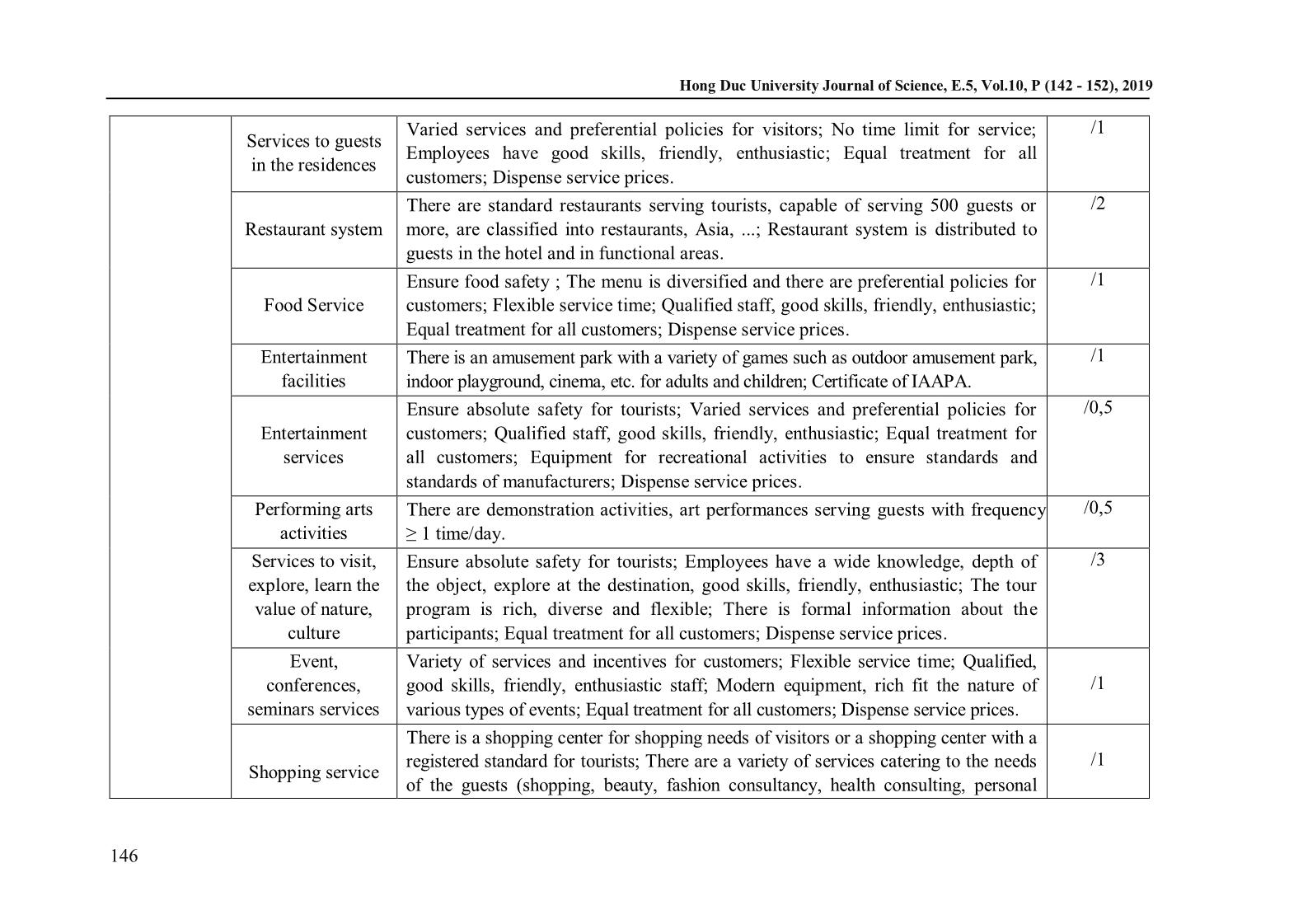
Trang 5
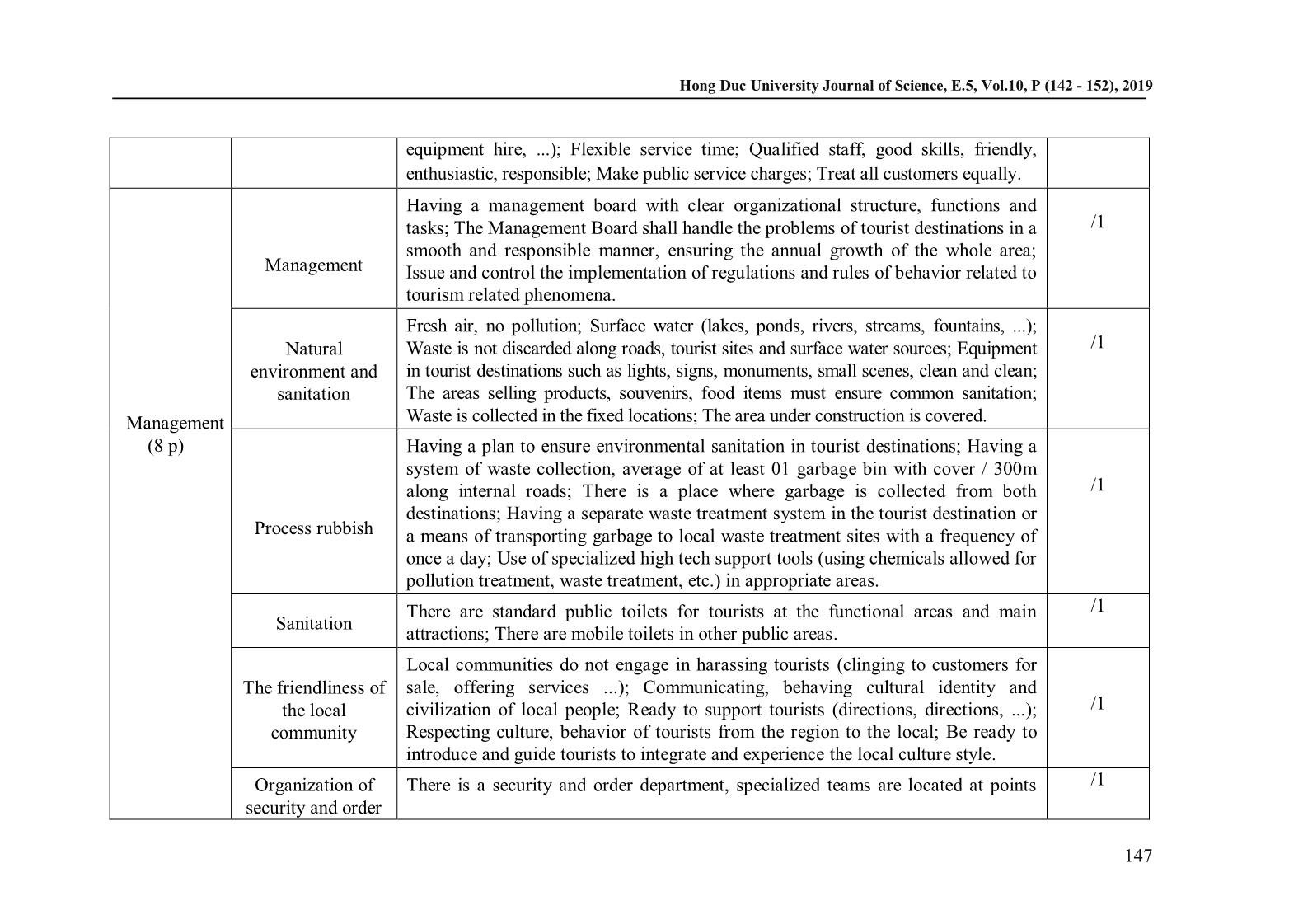
Trang 6
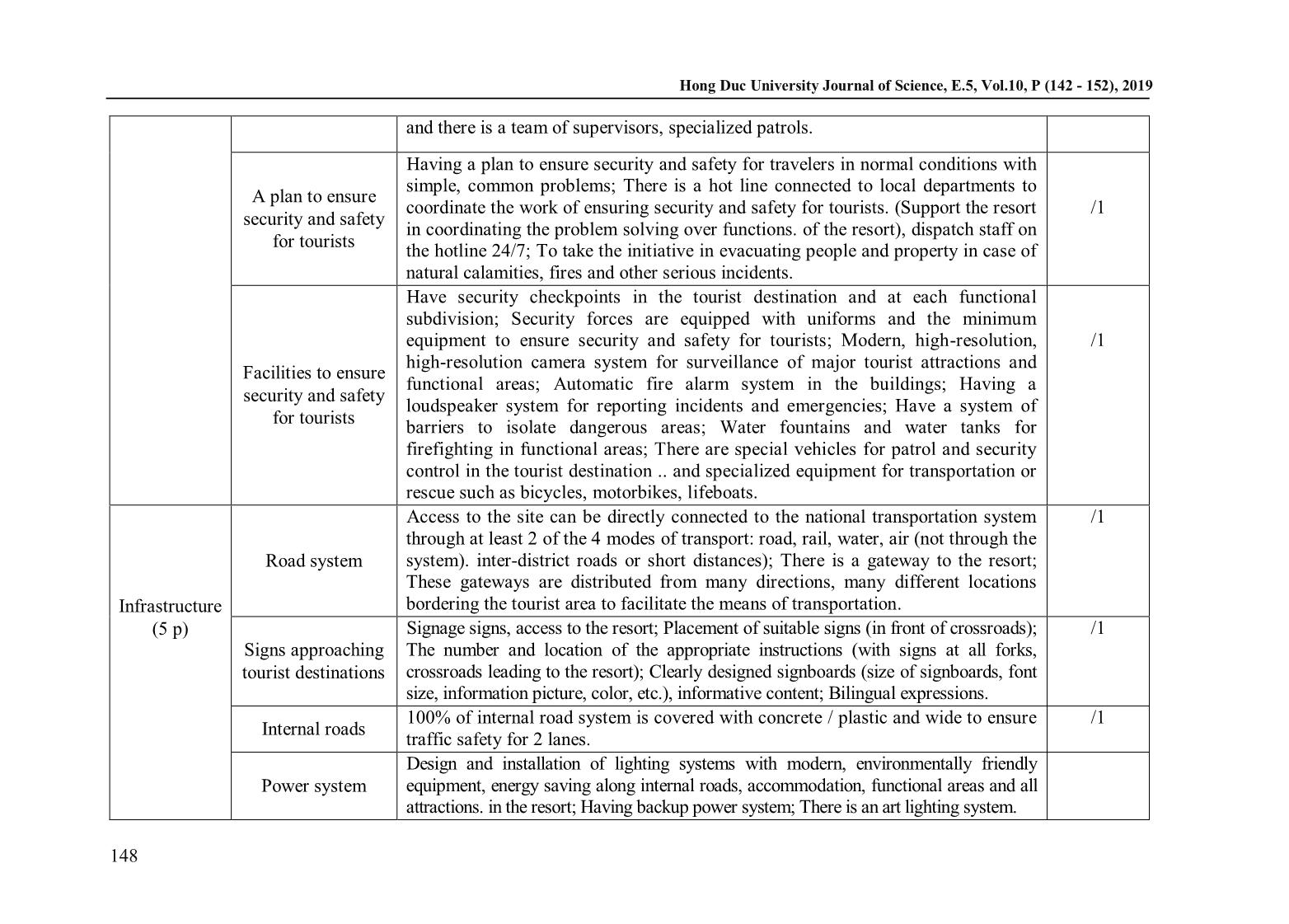
Trang 7
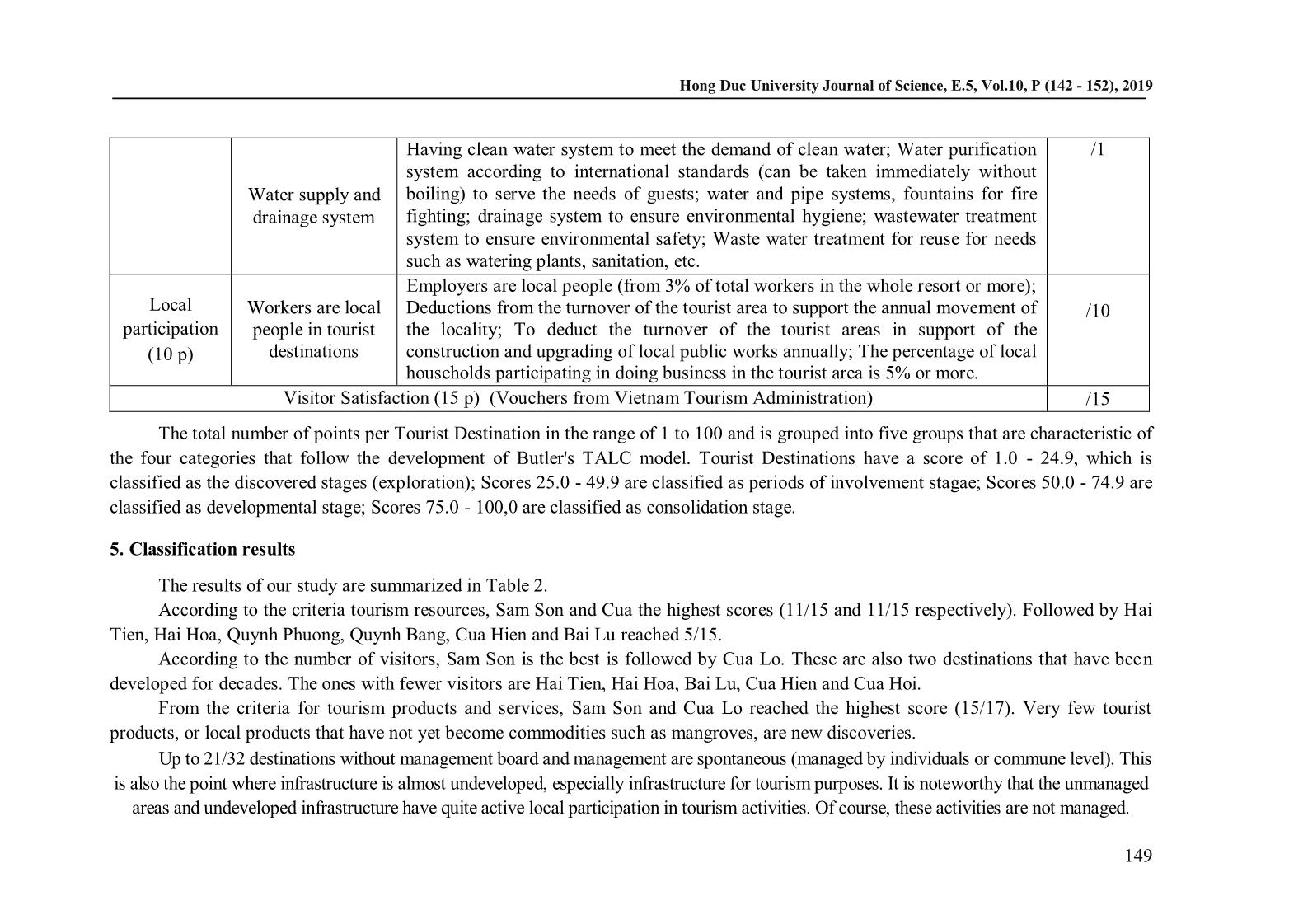
Trang 8
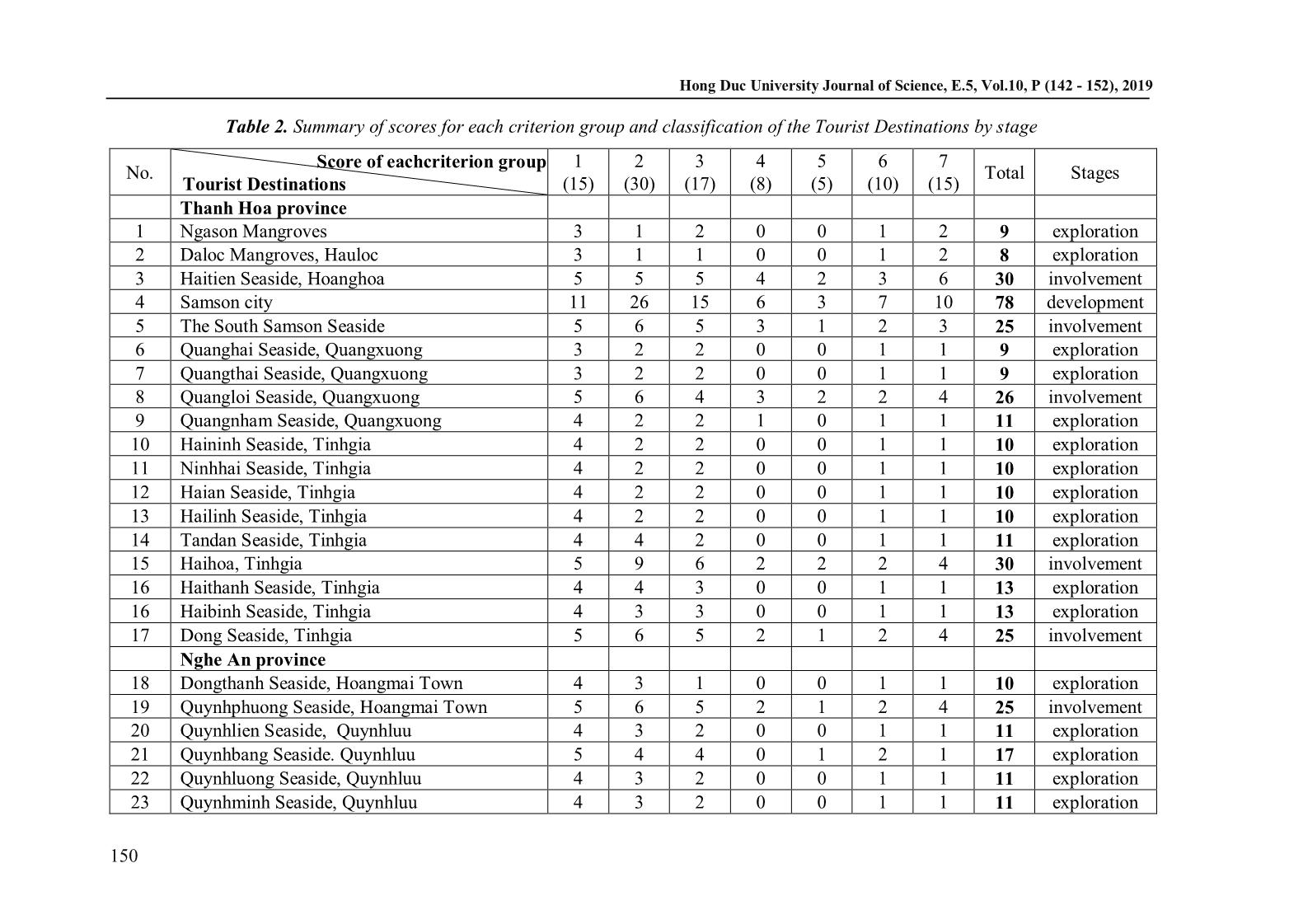
Trang 9
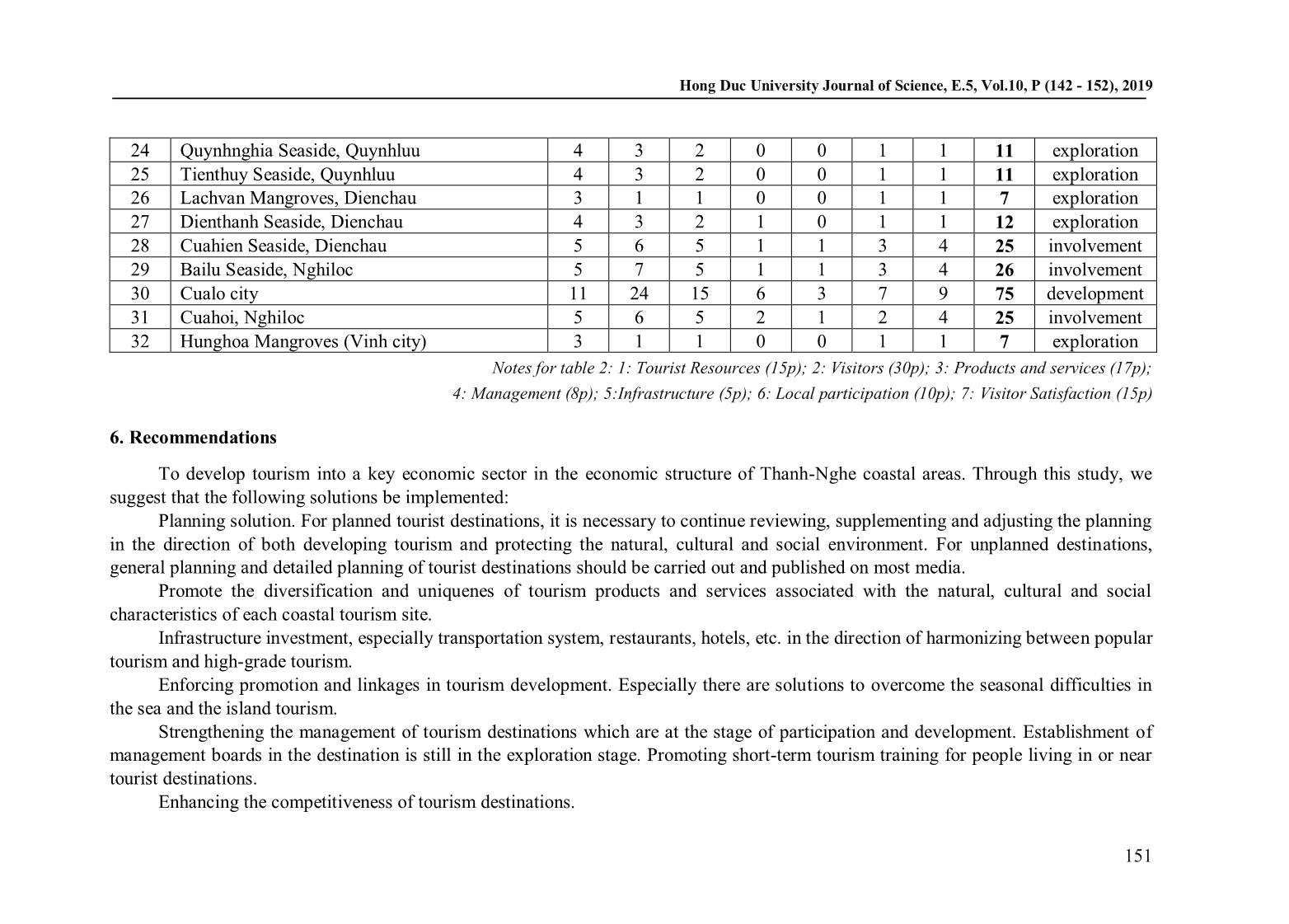
Trang 10
Tải về để xem bản đầy đủ
Bạn đang xem 10 trang mẫu của tài liệu "Applying the butler’s tourist area life cycle model to classify tourist destinations on Thanh Hoanghean’s coastline", để tải tài liệu gốc về máy hãy click vào nút Download ở trên
Tóm tắt nội dung tài liệu: Applying the butler’s tourist area life cycle model to classify tourist destinations on Thanh Hoanghean’s coastline
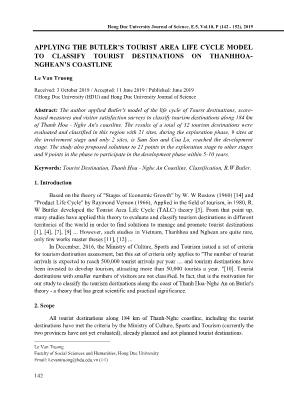
Flexible service time; Qualified staff, good skills, friendly, enthusiastic, responsible; Make public service charges; Treat all customers equally. Management (8 p) Management Having a management board with clear organizational structure, functions and tasks; The Management Board shall handle the problems of tourist destinations in a smooth and responsible manner, ensuring the annual growth of the whole area; Issue and control the implementation of regulations and rules of behavior related to tourism related phenomena. /1 Natural environment and sanitation Fresh air, no pollution; Surface water (lakes, ponds, rivers, streams, fountains, ...); Waste is not discarded along roads, tourist sites and surface water sources; Equipment in tourist destinations such as lights, signs, monuments, small scenes, clean and clean; The areas selling products, souvenirs, food items must ensure common sanitation; Waste is collected in the fixed locations; The area under construction is covered. /1 Process rubbish Having a plan to ensure environmental sanitation in tourist destinations; Having a system of waste collection, average of at least 01 garbage bin with cover / 300m along internal roads; There is a place where garbage is collected from both destinations; Having a separate waste treatment system in the tourist destination or a means of transporting garbage to local waste treatment sites with a frequency of once a day; Use of specialized high tech support tools (using chemicals allowed for pollution treatment, waste treatment, etc.) in appropriate areas. /1 Sanitation There are standard public toilets for tourists at the functional areas and main attractions; There are mobile toilets in other public areas. /1 The friendliness of the local community Local communities do not engage in harassing tourists (clinging to customers for sale, offering services ...); Communicating, behaving cultural identity and civilization of local people; Ready to support tourists (directions, directions, ...); Respecting culture, behavior of tourists from the region to the local; Be ready to introduce and guide tourists to integrate and experience the local culture style. /1 Organization of security and order There is a security and order department, specialized teams are located at points /1 Hong Duc University Journal of Science, E.5, Vol.10, P (142 - 152), 2019 148 F ac. o f G rad . S tu d ies, M ah id o l U n iv . M . M . (In tern atio n al H o sp itality M an ag em en t) / 1 4 8 and there is a team of supervisors, specialized patrols. A plan to ensure security and safety for tourists Having a plan to ensure security and safety for travelers in normal conditions with simple, common problems; There is a hot line connected to local departments to coordinate the work of ensuring security and safety for tourists. (Support the resort in coordinating the problem solving over functions. of the resort), dispatch staff on the hotline 24/7; To take the initiative in evacuating people and property in case of natural calamities, fires and other serious incidents. /1 Facilities to ensure security and safety for tourists Have security checkpoints in the tourist destination and at each functional subdivision; Security forces are equipped with uniforms and the minimum equipment to ensure security and safety for tourists; Modern, high-resolution, high-resolution camera system for surveillance of major tourist attractions and functional areas; Automatic fire alarm system in the buildings; Having a loudspeaker system for reporting incidents and emergencies; Have a system of barriers to isolate dangerous areas; Water fountains and water tanks for firefighting in functional areas; There are special vehicles for patrol and security control in the tourist destination .. and specialized equipment for transportation or rescue such as bicycles, motorbikes, lifeboats. /1 Infrastructure (5 p) Road system Access to the site can be directly connected to the national transportation system through at least 2 of the 4 modes of transport: road, rail, water, air (not through the system). inter-district roads or short distances); There is a gateway to the resort; These gateways are distributed from many directions, many different locations bordering the tourist area to facilitate the means of transportation. /1 Signs approaching tourist destinations Signage signs, access to the resort; Placement of suitable signs (in front of crossroads); The number and location of the appropriate instructions (with signs at all forks, crossroads leading to the resort); Clearly designed signboards (size of signboards, font size, information picture, color, etc.), informative content; Bilingual expressions. /1 Internal roads 100% of internal road system is covered with concrete / plastic and wide to ensure traffic safety for 2 lanes. /1 Power system Design and installation of lighting systems with modern, environmentally friendly equipment, energy saving along internal roads, accommodation, functional areas and all attractions. in the resort; Having backup power system; There is an art lighting system. Hong Duc University Journal of Science, E.5, Vol.10, P (142 - 152), 2019 149 F ac. o f G rad . S tu d ies, M ah id o l U n iv . M . M . (In tern atio n al H o sp itality M an ag e m en t) / 1 4 9 Water supply and drainage system Having clean water system to meet the demand of clean water; Water purification system according to international standards (can be taken immediately without boiling) to serve the needs of guests; water and pipe systems, fountains for fire fighting; drainage system to ensure environmental hygiene; wastewater treatment system to ensure environmental safety; Waste water treatment for reuse for needs such as watering plants, sanitation, etc. /1 Local participation (10 p) Workers are local people in tourist destinations Employers are local people (from 3% of total workers in the whole resort or more); Deductions from the turnover of the tourist area to support the annual movement of the locality; To deduct the turnover of the tourist areas in support of the construction and upgrading of local public works annually; The percentage of local households participating in doing business in the tourist area is 5% or more. /10 Visitor Satisfaction (15 p) (Vouchers from Vietnam Tourism Administration) /15 The total number of points per Tourist Destination in the range of 1 to 100 and is grouped into five groups that are characteristic of the four categories that follow the development of Butler's TALC model. Tourist Destinations have a score of 1.0 - 24.9, which is classified as the discovered stages (exploration); Scores 25.0 - 49.9 are classified as periods of involvement stagae; Scores 50.0 - 74.9 are classified as developmental stage; Scores 75.0 - 100,0 are classified as consolidation stage. 5. Classification results The results of our study are summarized in Table 2. According to the criteria tourism resources, Sam Son and Cua the highest scores (11/15 and 11/15 respectively). Followed by Hai Tien, Hai Hoa, Quynh Phuong, Quynh Bang, Cua Hien and Bai Lu reached 5/15. According to the number of visitors, Sam Son is the best is followed by Cua Lo. These are also two destinations that have been developed for decades. The ones with fewer visitors are Hai Tien, Hai Hoa, Bai Lu, Cua Hien and Cua Hoi. From the criteria for tourism products and services, Sam Son and Cua Lo reached the highest score (15/17). Very few tourist products, or local products that have not yet become commodities such as mangroves, are new discoveries. Up to 21/32 destinations without management board and management are spontaneous (managed by individuals or commune level). This is also the point where infrastructure is almost undeveloped, especially infrastructure for tourism purposes. It is noteworthy that the unmanaged areas and undeveloped infrastructure have quite active local participation in tourism activities. Of course, these activities are not managed. Hong Duc University Journal of Science, E.5, Vol.10, P (142 - 152), 2019 150 F ac. o f G rad . S tu d ies, M ah id o l U n iv . M . M . (In tern atio n al H o sp itality M an ag em en t) / 1 5 0 Table 2. Summary of scores for each criterion group and classification of the Tourist Destinations by stage No. Score of eachcriterion group Tourist Destinations 1 (15) 2 (30) 3 (17) 4 (8) 5 (5) 6 (10) 7 (15) Total Stages Thanh Hoa province 1 Ngason Mangroves 3 1 2 0 0 1 2 9 exploration 2 Daloc Mangroves, Hauloc 3 1 1 0 0 1 2 8 exploration 3 Haitien Seaside, Hoanghoa 5 5 5 4 2 3 6 30 involvement 4 Samson city 11 26 15 6 3 7 10 78 development 5 The South Samson Seaside 5 6 5 3 1 2 3 25 involvement 6 Quanghai Seaside, Quangxuong 3 2 2 0 0 1 1 9 exploration 7 Quangthai Seaside, Quangxuong 3 2 2 0 0 1 1 9 exploration 8 Quangloi Seaside, Quangxuong 5 6 4 3 2 2 4 26 involvement 9 Quangnham Seaside, Quangxuong 4 2 2 1 0 1 1 11 exploration 10 Haininh Seaside, Tinhgia 4 2 2 0 0 1 1 10 exploration 11 Ninhhai Seaside, Tinhgia 4 2 2 0 0 1 1 10 exploration 12 Haian Seaside, Tinhgia 4 2 2 0 0 1 1 10 exploration 13 Hailinh Seaside, Tinhgia 4 2 2 0 0 1 1 10 exploration 14 Tandan Seaside, Tinhgia 4 4 2 0 0 1 1 11 exploration 15 Haihoa, Tinhgia 5 9 6 2 2 2 4 30 involvement 16 Haithanh Seaside, Tinhgia 4 4 3 0 0 1 1 13 exploration 16 Haibinh Seaside, Tinhgia 4 3 3 0 0 1 1 13 exploration 17 Dong Seaside, Tinhgia 5 6 5 2 1 2 4 25 involvement Nghe An province 18 Dongthanh Seaside, Hoangmai Town 4 3 1 0 0 1 1 10 exploration 19 Quynhphuong Seaside, Hoangmai Town 5 6 5 2 1 2 4 25 involvement 20 Quynhlien Seaside, Quynhluu 4 3 2 0 0 1 1 11 exploration 21 Quynhbang Seaside. Quynhluu 5 4 4 0 1 2 1 17 exploration 22 Quynhluong Seaside, Quynhluu 4 3 2 0 0 1 1 11 exploration 23 Quynhminh Seaside, Quynhluu 4 3 2 0 0 1 1 11 exploration Hong Duc University Journal of Science, E.5, Vol.10, P (142 - 152), 2019 151 F ac. o f G rad . S tu d ies, M ah id o l U n iv . M . M . (In tern atio n al H o sp itality M an ag e m en t) / 1 5 1 24 Quynhnghia Seaside, Quynhluu 4 3 2 0 0 1 1 11 exploration 25 Tienthuy Seaside, Quynhluu 4 3 2 0 0 1 1 11 exploration 26 Lachvan Mangroves, Dienchau 3 1 1 0 0 1 1 7 exploration 27 Dienthanh Seaside, Dienchau 4 3 2 1 0 1 1 12 exploration 28 Cuahien Seaside, Dienchau 5 6 5 1 1 3 4 25 involvement 29 Bailu Seaside, Nghiloc 5 7 5 1 1 3 4 26 involvement 30 Cualo city 11 24 15 6 3 7 9 75 development 31 Cuahoi, Nghiloc 5 6 5 2 1 2 4 25 involvement 32 Hunghoa Mangroves (Vinh city) 3 1 1 0 0 1 1 7 exploration Notes for table 2: 1: Tourist Resources (15p); 2: Visitors (30p); 3: Products and services (17p); 4: Management (8p); 5:Infrastructure (5p); 6: Local participation (10p); 7: Visitor Satisfaction (15p) 6. Recommendations To develop tourism into a key economic sector in the economic structure of Thanh-Nghe coastal areas. Through this study, we suggest that the following solutions be implemented: Planning solution. For planned tourist destinations, it is necessary to continue reviewing, supplementing and adjusting the planning in the direction of both developing tourism and protecting the natural, cultural and social environment. For unplanned destinations, general planning and detailed planning of tourist destinations should be carried out and published on most media. Promote the diversification and uniquenes of tourism products and services associated with the natural, cultural and social characteristics of each coastal tourism site. Infrastructure investment, especially transportation system, restaurants, hotels, etc. in the direction of harmonizing between popular tourism and high-grade tourism. Enforcing promotion and linkages in tourism development. Especially there are solutions to overcome the seasonal difficulties in the sea and the island tourism. Strengthening the management of tourism destinations which are at the stage of participation and development. Establishment of management boards in the destination is still in the exploration stage. Promoting short-term tourism training for people living in or near tourist destinations. Enhancing the competitiveness of tourism destinations. Hong Duc University Journal of Science, E.5, Vol.10, P (142 - 152), 2019 152 F ac. o f G rad . S tu d ies, M ah id o l U n iv . M . M . (In tern atio n al H o sp itality M an ag em en t) / 1 5 2 References [1] L. Alex (1997), Applications of Life-cycle tourism, Analysis tourism research [2] Buckley, Peter (1999), In Memory of Raymond Vernon, Journal of International Business Studies. 30 (3): iv. doi: 10.1057 / jibs.1999.29. JSTOR 155458. [3] Butler, R.W. (1980), The concept of a tourism area cycle of evolution: Implication for management of resources, Canadian Geographer. No 24, p.5-12. [4] Butler, R.W. (1985), Evolution of tourism in the Scottish highlands. Annals of tourism research, Canadian Geographer [5] Cooper, C. & Jackson (1989), Destination life cycle: The isle of Man case study. Annals of tourism research vol.16 [6] Gilbert, D. (1990), Strategic marketing planning for national tourism. Tourist Review..Hay wood, K. (1986), Tourism and tourism [7] Knowles, T. and Curtis, S. (1999), The market viability of European mass tourist destinations. A post-stagnation life-cycle analysis. Tourism Research. [8] Moon, Y.M, (2005), The tourism area life cycle [9] Rick Lagiewski (2006), The application of the TALC model: a literature survey. Rochester Institute of Technology RIT Scholarly Works Articles. [10] The Ministry of Culture, Sports and Tourism (2016), Set criteria for tourism destination assessment. Decision No. 4640. [11] Vu Thi Thuy (2014), Ha Giang tourism development solution is based on the life cycle theory of tourism destination. Master thesis. University of Social Sciences and Humanities. Hanoi National University. [12] Trinh Thi Thuyet (2018), Tourism Development Sam Son City 2010 - 2017. Thesis. University of Education, Thai Nguyen University. [13] Le Van Truong (2017), Introduction to Tourist. Training materials under the scheme Develop training programs to improve the quality of tourism business management according to international standard model 2016-2020 under the Decision No. 1358 / QD-UBND dated 27/4-/2017 of Chairman of Thanh Hoa People's Committee. [14] Walt Witman Rostov (1960), Stages of Economic Growth. Cambridge University.
File đính kèm:
 applying_the_butlers_tourist_area_life_cycle_model_to_classi.pdf
applying_the_butlers_tourist_area_life_cycle_model_to_classi.pdf

